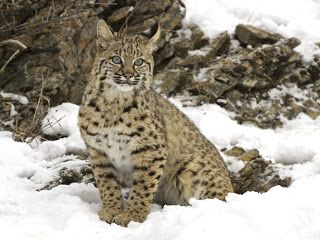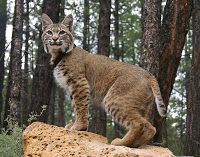 This week we’ll be introducing you to the bobcat! An “elusive” creature as Camp Foley’s Director, Alli Faricy, put it. According to the Minnesota Department of Natural Resources (DNR), “Few humans ever see a bobcat in the wild.”
This week we’ll be introducing you to the bobcat! An “elusive” creature as Camp Foley’s Director, Alli Faricy, put it. According to the Minnesota Department of Natural Resources (DNR), “Few humans ever see a bobcat in the wild.”
The bobcat is the smallest of all four species in the Lynx genus. Bobcats can weigh between 10 and 40 pounds and stands one to two feet tall. Generally, it is tan to grayish-brown on top with a white belly and it has
black streaks or spots. The ears of the bobcat are black-tipped and pointed, with short, black tufts.
Bobcats have excellent hearing and vision, and a good sense of smell. Plus, it is an excellent climber (they have been known to climb trees and catch and eat porcupines!) and can swim (but tends to avoid water)! The bobcat is muscular, and its hind legs are longer than its front legs, which gives it a bobbing walk. However, this is not why the animal is named the bobcat…
 Second bobcat fun fact: Bobcats are named for its “bob” tail, which looks as though it has been cut off at about five inches long!
Second bobcat fun fact: Bobcats are named for its “bob” tail, which looks as though it has been cut off at about five inches long! Bobcats used to live across the state, but now it is seldom found in southern Minnesota. It most commonly lives in the woodlands of north-central and northeastern Minnesota. Bobcats are a designated game animal, meaning they can be hunted, but only during the prescribed seasons. It is typically hunted – with hounds – for its fur.
Bobcats used to live across the state, but now it is seldom found in southern Minnesota. It most commonly lives in the woodlands of north-central and northeastern Minnesota. Bobcats are a designated game animal, meaning they can be hunted, but only during the prescribed seasons. It is typically hunted – with hounds – for its fur.